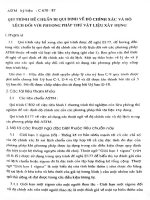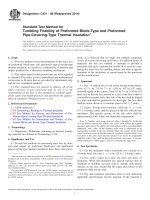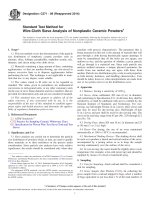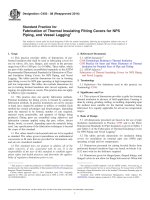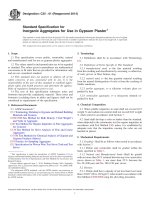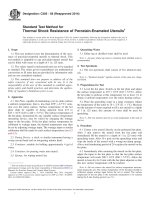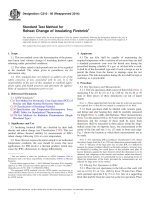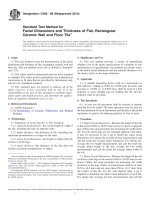Astm c 346 87 (2014)
Bạn đang xem bản rút gọn của tài liệu. Xem và tải ngay bản đầy đủ của tài liệu tại đây (73.67 KB, 3 trang )
Designation: C346 − 87 (Reapproved 2014)
Standard Test Method for
45-deg Specular Gloss of Ceramic Materials1
This standard is issued under the fixed designation C346; the number immediately following the designation indicates the year of
original adoption or, in the case of revision, the year of last revision. A number in parentheses indicates the year of last reapproval. A
superscript epsilon (´) indicates an editorial change since the last revision or reapproval.
1. Scope
tion when the axis of reception coincides with the mirror image
of the axis of illumination.
1.1 This test method covers the determination of the specular gloss of porcelain enameled specimens, but may be applicable to other specimens having similar reflection characteristics. This test method may be used to compare the gloss of
porcelain enameled specimens or to provide an index of acid or
abrasion resistance by measurement of gloss loss.
NOTE 3—In this operational definition, the quantity defined as specular
gloss is composed of surface-reflected and body-reflected components.
For some low-gloss measurements, an approximate evaluation of the
surface-reflected component of specular gloss may be required (see
Section 9).
NOTE 1—Specular gloss is one of several related appearance attributes
that produce the sensation of glossiness. For this reason, specular gloss
measurements may not always correlate well with visual rankings of
glossiness.
NOTE 2—Improved correlations with visual judgments can sometimes
be achieved by the use of instruments with different geometries than those
specified herein. Refer to Test Method D523 for 20, 60, and 85-deg
geometries. Values generally cannot be predicated for one geometry from
measurements made with another.
NOTE 4—Under ideal conditions, the incident beam should consist of
parallel light, and only light reflected in the true direction of mirror
reflection should be accepted for measurement.
3.1.2 45-deg specular gloss—fraction of visible light incident upon the specimens at 45° to the normal that is reflected
in the direction of mirror reflection.
3.1.3 source aperture—angular size (solid angle) of the light
source (lamp filament, if an incandescent source is used)
measured from the center of the incident beam lens.
3.1.4 receptor aperture—angular size (solid angle) of the
receptor window, measured from the center of the receptor
lens.
1.2 This standard does not purport to address all of the
safety concerns, if any, associated with its use. It is the
responsibility of the user of this standard to establish appropriate safety and health practices and determine the applicability of regulatory limitations prior to use.
4. Significance and Use
2. Referenced Documents
4.1 This test method may be used to compare the gloss of
porcelain enamel, ceramic, and other finishes or to provide a
comparison of their resistance to attack from acid, alkali, or
other environmental factors by measurement of gloss loss.
2.1 ASTM Standards:2
D523 Test Method for Specular Gloss
E97 Method of Test for Directional Reflectance Factor,
45-Deg 0-Deg, of Opaque Specimens by Broad-Band
Filter Reflectometry (Withdrawn 1991)3
5. Apparatus
5.1 Instrumental Components—The apparatus shall consist
of an incandescent light source and lens furnishing an incident
beam of rays of required aperture, means for locating the
surface of the specimen, and a receptor located to receive the
required pyramid of rays reflected from the specimen. The
receptor shall be a photosensitive device having maximum
response near the middle of the visible region of the spectrum.
3. Terminology
3.1 Definitions:
3.1.1 specular gloss—ratio of reflected to incident light,
times 1000, for specified apertures of illumination and recep1
This test method is under the jurisdiction of ASTM Committee B08 on Metallic
and Inorganic Coatings and is the direct responsibility of Subcommittee B08.12 on
Materials for Porcelain Enamel and Ceramic-Metal Systems. 19th St., Suite 200,
Arlington, VA 22209.
Current edition approved May 1, 2014. Published May 2014. Originally
approved in 1954. Last previous edition approved in 2009 as C346 – 87 (2009).
DOI: 10.1520/C0346-87R14.
2
For referenced ASTM standards, visit the ASTM website, www.astm.org, or
contact ASTM Customer Service at For Annual Book of ASTM
Standards volume information, refer to the standard’s Document Summary page on
the ASTM website.
3
The last approved version of this historical standard is referenced on
www.astm.org.
5.2 Geometric Conditions—The axis of the incident beam
shall be 45° from the perpendicular to the specimen surface.
The axis of the receptor beam shall be coincident with the
mirror image of the axis of the incident beam. A flat piece of
polished black glass in the specimen position shall form an
image of the source in the center of the receptor window. The
angular dimensions of the source and receptor shall be as
specified below:
Copyright © ASTM International, 100 Barr Harbor Drive, PO Box C700, West Conshohocken, PA 19428-2959. United States
1
C346 − 87 (2014)
Apertures
Source
Receiver
In Plane of
Measurement,A deg
1.4 ± 0.4
8.0 ± 0.1
8.2 Set the instrument to read the assigned gloss value of a
highly polished working standard; then read the gloss of lower
glass standards having poorer image-forming characteristics. If
the instrument readings for the latter standards do not agree
with the assigned values to within two gloss units, the
instrument optics may require readjustment; preferably, this
should be done by the manufacturer.
Perpendicular to Plane
of Measurement,A deg
3.0 ± 1.0
10.0 ± 0.2
A
“Plane of measurement” is the plane containing axes of illuminating and viewing
beams.
8.3 Measure the gloss of at least three portions of each
specimen surface. This will give an indication of gloss uniformity.
8.4 For evaluation of change of gloss of a single specimen,
which may be used as a measurement of surface deterioration
of porcelain enameled or ceramic specimens, exercise particular care to see that the glossmeter is in exactly the same
position on the specimen for measurements before and after
treatment and that the illuminating beam is oriented the same
on the specimen. For best results, make several measurements
on each specimen in different reproducible positions.
6. Specular Gloss Standards
6.1 Specular Gloss Standards— Primary working standards
shall be highly polished, plane, black-glass surfaces, or surfaces of liquids for which the gloss is calculated from the angle
of incidence and the refractive index of the material by using
Fresnel’s equation. Polished black glass of refractive index
1.540 shall be assigned a 45-deg specular gloss value of 55.9.
For the usual variation of refractive index of black glass, a
change in index of 0.001 changes the gloss reading by 0.14.
NOTE 5—For small square or rectangular specimens, such as those
frequently used for laboratory tests, a specimen stop attached to the
glossmeter head will permit exact duplication of specimen position and
orientation.
6.2 Secondary Working Standards —Secondary working
standards of ceramic tile, glass, porcelain enamel, or other
materials having hard and uniform surfaces may be calibrated
from the primary standards on a glossmeter determined to be in
strict conformance with the requirements prescribed in 5.2.
9. Evaluation of Components of Specular Gloss
9.1 When required (Note 6), an approximate evaluation of
the two components of specular gloss may be made as follows:
9.1.1 Body-Reflected Component—Obtain an approximate
evaluation of the body-reflected component (formerly called
“diffuse correction”) of specular gloss by one of the following
two procedures:
9.1.1.1 Adjust a goniophotometer to read 45-deg specular
gloss; then illuminate the specimen perpendicularly and view it
at 45 deg with the same receptor aperture as specified in 5.2.
Read the magnitude of the body-reflected component.
9.1.1.2 Alternatively, measure the 45-deg, 0-deg luminous
directional reflectance in accordance with Method E97; express
their reflectance as a decimal fraction and multiply by 5.5 to
obtain an approximate value for the body-reflected component
of specular gloss.
9.1.2 Surface-Reflected Component —Subtract the bodyreflected component from the measured specular gloss to
obtain the surface-reflected component.
6.3 For greatest accuracy, always orient the standards to the
position in which they were originally calibrated.
6.4 The importance of the cleanliness of glass standards
cannot be overemphasized. They must always be handled
carefully to avoid abrading the surfaces. One or two deep
scratches will not reduce the gloss as much as a large number
of almost imperceptible abrasions.
6.4.1 Never use abrasive cleaners or scouring powders on
standards.
6.4.2 When standards are washed in soap and water, a thin
film of soap or oil may remain on the tile surface, thus resulting
in a spurious gloss value. This effect has been found to be most
noticeable for metal tiles and for higher angle and low gloss
values.
6.4.3 The use of a mild detergent is recommended. Reproducible cleaning of standards can be accomplished by brushing
them in a solution of detergent and water, 3 g/L (1 tbsp/gal)
with a nylon brush followed by a forced rinse in hot water
(temperature near 66°C (150°F)), with the tile immediately
blotted dry with a clean paper towel. The tile must not be
rubbed with the hand or paper towel, either during washing or
drying.
NOTE 6—Evaluation of surface-reflected and body-reflected components of specular gloss will ordinarily be required only when comparing
low-gloss specimens having quite different diffuse (body) reflectance.
10. Calculation
10.1 In computing the percent of gloss retained or lost,
make a separate computation for each location measured and
average results after computation.
7. Test Specimens
7.1 Only surfaces of good planarity shall be tested, if
possible, since surface warpage, waviness, or curvature will
affect test results seriously.
10.2 Calculate percent change in gloss as follows:
Gloss loss, % 5
8. Procedure
8.1 Operate the glossmeter according to the instructions of
the manufacturer.
Gi 2 Gf
3 100
Gi
Gloss retained, % 5
2
Gf
3 100
Gi
C346 − 87 (2014)
where:
Gi = initial gloss (before treatment), and
Gf = final gloss (after treatment).
11.3 Identify the glossmeter by the name of the manufacturer and model designation.
11. Report
12. Precision and Bias
11.1 Report the average specular gloss reading of each
specimen. When required, report the surface-reflected and
body-reflected components separately.
12.1 The precision and bias of this test method is being
established.
11.2 Report the presence of any specimen for which portions of the test surface differ in gloss from the average by
more than 10 % of the average.
13. Keywords
11.4 Identify the standards used, if desired.
13.1 ceramic materials-glazed; glass coating; porcelain
enamel; specular gloss
ASTM International takes no position respecting the validity of any patent rights asserted in connection with any item mentioned
in this standard. Users of this standard are expressly advised that determination of the validity of any such patent rights, and the risk
of infringement of such rights, are entirely their own responsibility.
This standard is subject to revision at any time by the responsible technical committee and must be reviewed every five years and
if not revised, either reapproved or withdrawn. Your comments are invited either for revision of this standard or for additional standards
and should be addressed to ASTM International Headquarters. Your comments will receive careful consideration at a meeting of the
responsible technical committee, which you may attend. If you feel that your comments have not received a fair hearing you should
make your views known to the ASTM Committee on Standards, at the address shown below.
This standard is copyrighted by ASTM International, 100 Barr Harbor Drive, PO Box C700, West Conshohocken, PA 19428-2959,
United States. Individual reprints (single or multiple copies) of this standard may be obtained by contacting ASTM at the above
address or at 610-832-9585 (phone), 610-832-9555 (fax), or (e-mail); or through the ASTM website
(www.astm.org). Permission rights to photocopy the standard may also be secured from the Copyright Clearance Center, 222
Rosewood Drive, Danvers, MA 01923, Tel: (978) 646-2600; />
3
